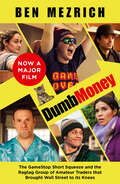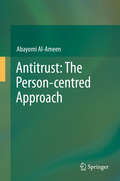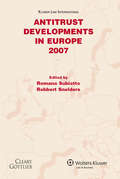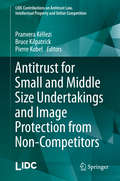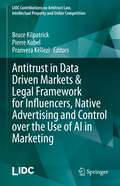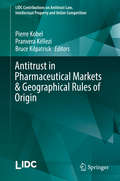- Table View
- List View
Antimonopoly and American Democracy
by Daniel A. Crane and William J. NovakAmericans today worry about concentrated power in private industry to an extent not seen in generations. Not only do they find diminished diversity of service-providers and producers, but they are disquieted by the power of a few large companies to shape and constrain democratic processes. Americans across the political spectrum, from former President Donald Trump to Massachusetts Senator Elizabeth Warren, have sounded alarms about the overlarge power of business in both public and private life. While many of the technologies and industries that worry Americans are new, the concerns they've raised are not unprecedented. Antimonopoly and American Democracy traces the history of antimonopoly politics in the United States, arguing that organized action against concentrated economic power comprises an important American democratic tradition. While prevailing narratives tend to treat monopoly as a risk to people mainly in their roles as consumers--by causing prices to increase, for example--this study broadens the conversation, recounting ways in which monopolism can hurt ordinary people without directly impacting their wallets. From the pre-revolutionary era to the age of Big Tech, the volume explores the effects that historical monopolies have had on democracy by using their wealth and influence to dominate electoral politics and regulation. Chapters also highlight a range of sites of economic concentration, from land ownership to media reach, and attempts at combating them, from labor organizing to constitutional revision. Featuring original scholarship from some of the world's leading experts in American economic, political, and legal history, Antimonopoly and American Democracy offers important lessons for our contemporary political moment, in which fears of concentrated wealth and influence are again on the rise.
Antimonopoly and American Democracy
Americans today worry about concentrated power in private industry to an extent not seen in generations. Not only do they find diminished diversity of service-providers and producers, but they are disquieted by the power of a few large companies to shape and constrain democratic processes. Americans across the political spectrum, from former President Donald Trump to Massachusetts Senator Elizabeth Warren, have sounded alarms about the overlarge power of business in both public and private life. While many of the technologies and industries that worry Americans are new, the concerns they've raised are not unprecedented. Antimonopoly and American Democracy traces the history of antimonopoly politics in the United States, arguing that organized action against concentrated economic power comprises an important American democratic tradition. While prevailing narratives tend to treat monopoly as a risk to people mainly in their roles as consumers--by causing prices to increase, for example--this study broadens the conversation, recounting ways in which monopolism can hurt ordinary people without directly impacting their wallets. From the pre-revolutionary era to the age of Big Tech, the volume explores the effects that historical monopolies have had on democracy by using their wealth and influence to dominate electoral politics and regulation. Chapters also highlight a range of sites of economic concentration, from land ownership to media reach, and attempts at combating them, from labor organizing to constitutional revision. Featuring original scholarship from some of the world's leading experts in American economic, political, and legal history, Antimonopoly and American Democracy offers important lessons for our contemporary political moment, in which fears of concentrated wealth and influence are again on the rise.
Antipatterns: Managing Software Organizations and People, Second Edition (Applied Software Engineering Series)
by Colin J. Neill Philip A. Laplante Joanna F. DeFrancoEmphasizing leadership principles and practices, Antipatterns: Managing Software Organizations and People, Second Edition catalogs 49 business practices that are often precursors to failure. This updated edition of a bestseller not only illustrates bad management approaches, but also covers the bad work environments and cultural traits commonly fou
Antipatterns: Managing Software Organizations and People, Second Edition (Applied Software Engineering Series)
by Colin J. Neill Philip A. Laplante Joanna F. DeFrancoEmphasizing leadership principles and practices, Antipatterns: Managing Software Organizations and People, Second Edition catalogs 49 business practices that are often precursors to failure. This updated edition of a bestseller not only illustrates bad management approaches, but also covers the bad work environments and cultural traits commonly fou
Antiracist Leadership: A Spiritual Approach to Diversity, Equity, and Inclusion (Palgrave Studies in Workplace Spirituality and Fulfillment)
by Douglas J. CremerThis book presents a new vision and strategy for a spiritual antiracism that values diversity, equity, and inclusion. Employing the practice of seeing, choosing, and acting as a framework, it examines the role of Christian spirituality, which includes religious values, interpretations of scripture and tradition, and general concerns with the human soul. Christian spirituality was integral to developing and justifying an ideology of “white” supremacy and Christian spirituality has the potential for resisting and rejecting this same racism. Responding to the very idea of “race,” born from the ideology of racism and “white” supremacy, the author shows how to envision and implement a spiritual approach that respects both human dignity and individual distinctiveness. Understanding the fundamental value of human dignity as deeply rooted in the Christian tradition serves as one antidote for other readings of the tradition that can be used to justify oppression and segregation. This book addresses those interested in leadership in challenging times buffeted by issues of racism, privilege, and power in our communities, workplaces, and lives. It will appeal to those who are seeking how to lead within the tensions of these times with fresh approaches to questions of diversity, equity, and inclusion.
The Antisocial Network
by Ben MezrichThis is definitive take on the wildest story of the year— the David-vs.-Goliath GameStop short squeeze, a tale of fortunes won and lost overnight that may end up changing Wall Street forever.
Antisoziales: Eine Kurzanalyse aus der Perspektive der „Dunklen Triade“ (essentials)
by Karin MeyerNarzissmus gilt auf Führungsetagen als ein verbreitetes Phänomen, das dort im Vergleich zur restlichen Bevölkerung überdurchschnittlich stark repräsentiert ist. Weiterhin weisen jüngere Nachwuchs(führungs-)kräfte deutlich höhere Narzissmus-Ausprägungen auf als dies in den älteren Generationen bislang der Fall war. Gleichzeitig treten Verhaltenszüge der Dunklen Triade (Narzissmus, Machiavellismus und Psychopathie) meist nicht isoliert, sondern in Kombination auf. Unternehmen sollten aus diesem Grund schon heute ihre Personalauswahl, -führung und -entwicklung überdenken. Beleuchtet werden daher Merkmale und Verhaltensmuster rücksichtsloser Personen der Dunklen Triade – ebenso mögliche Ansätze zur Intervention und Prävention.
Antiterrorism and Threat Response: Planning and Implementation
by Ross JohnsonOne of the single greatest challenges to security professionals in the 21st century is terrorism. In the last several years, we have heard a lot about the importance of preparing for terrorist attacks. This book offers a way to prevent terrorist attacks. Providing security managers with a clear and simple methodology to protect their organizations,
Antiterrorism and Threat Response: Planning and Implementation
by Ross JohnsonAs security professionals, we tend to get seduced by the beauty of our technology. We go to trade exhibitions filled with the latest innovations and marvel at what we see without understanding how it fits in with what we do. It’s both overwhelming and distracting, like trying to learn to cook by walking through a grocery store.This focus on technology teaches us to judge the effectiveness of physical protection systems by the strength of the barriers, the acuity of the cameras, and the sensitivity of the sensors. Terrorists and criminals look for something else entirely, though: where we see strength, they find weakness and vulnerability. We are looking at the same things, but not seeing the same things. If we want to stop them, we need to know more than how they work. We need to learn to see the way they see.A physical protection system - that collection of people, sensors, barriers, policies, and technology – is a lot like a piano: and you cannot tell if a piano is in tune by looking at it. You have to play it. The major contribution of Antiterrorism and Threat Response: Planning and Implementation, 2e is the detailed instruction and practical advice on how to see the weaknesses and vulnerabilities in physical protection systems and upgrade them to meet the challenges of terrorists and criminals. Key features of this book are: Provides professionals with the background to understand how terrorists think and operate, in order to best coordinate their counterterrorism efforts and antiterrorism strategies Examines difficult new problems facing security professionals: such as the use of drones, guns, and the internet as a tool of both recruitment and indoctrination Teaches the reader how to step outside the security department to find and fix weaknesses and vulnerabilities in physical protection systems Introduces and discusses security management and insider threat risk management programs This is the advanced course in protecting physical assets from terrorists and criminals.
Antiterrorism and Threat Response: Planning and Implementation
by Ross JohnsonAs security professionals, we tend to get seduced by the beauty of our technology. We go to trade exhibitions filled with the latest innovations and marvel at what we see without understanding how it fits in with what we do. It’s both overwhelming and distracting, like trying to learn to cook by walking through a grocery store.This focus on technology teaches us to judge the effectiveness of physical protection systems by the strength of the barriers, the acuity of the cameras, and the sensitivity of the sensors. Terrorists and criminals look for something else entirely, though: where we see strength, they find weakness and vulnerability. We are looking at the same things, but not seeing the same things. If we want to stop them, we need to know more than how they work. We need to learn to see the way they see.A physical protection system - that collection of people, sensors, barriers, policies, and technology – is a lot like a piano: and you cannot tell if a piano is in tune by looking at it. You have to play it. The major contribution of Antiterrorism and Threat Response: Planning and Implementation, 2e is the detailed instruction and practical advice on how to see the weaknesses and vulnerabilities in physical protection systems and upgrade them to meet the challenges of terrorists and criminals. Key features of this book are: Provides professionals with the background to understand how terrorists think and operate, in order to best coordinate their counterterrorism efforts and antiterrorism strategies Examines difficult new problems facing security professionals: such as the use of drones, guns, and the internet as a tool of both recruitment and indoctrination Teaches the reader how to step outside the security department to find and fix weaknesses and vulnerabilities in physical protection systems Introduces and discusses security management and insider threat risk management programs This is the advanced course in protecting physical assets from terrorists and criminals.
Antitrust: The Person-centred Approach
by Abayomi Al-AmeenThis book proposes a different approach to theorising and analysing antitrust issues, working on the premise that at present, antitrust is addressed from top-down and narrow perspectives which in effect limit the attention paid to or exclude issues that could otherwise be considered. This reasoning is motivated by the pursuit of inclusiveness and broadness in the antitrust context. The work contends that traditional top-down antitrust theories are weak because they are incomplete and insufficient in their description and analysis of antitrust issues. Thus, it identifies the need to construct a bottom-up approach. Invariably, such an approach would have to avoid ex ante judgments about the suitability of the normative contents of antitrust laws and theories, lest it fall into the same trap that plagues traditional theories. As a possible solution, the author proposes a procedural account referred to as the person-centred approach (built on theories such as Sen’s Capability) and carefully reviews its practicality.
Antitrust Analysis of Online Sales Platforms & Copyright Limitations and Exceptions (LIDC Contributions on Antitrust Law, Intellectual Property and Unfair Competition)
by Bruce Kilpatrick Pierre Kobel Pranvera KëlleziThis book gathers international and national reports from across the globe on key questions in the field of antitrust and intellectual property.The first part discusses the application of competition law to online sales platforms, which is increasingly a focus for anti-trust authorities around the world. A detailed international report explores which are the major challenges for competition law generated by the growth of online platforms. It provides an excellent comparative study of this complex and challenging subject.The second part of the book gathers contributions from various jurisdictions on the topic “To what extent do current exclusions and limitations to copyright strike a fair balance between the rights of owners and fair use by private individuals and others ?" This section presents an international report, which offers an unparalleled comparative analysis of this topic, bringing together common themes and contrasting the various national provisions dealing with exceptions to copyright, amongst other things.The book also includes the resolutions passed by the General Assembly of the International League of Competition Law (LIDC) following a debate on each of these topics, which include proposed solutions and recommendations. The LIDC is a long-standing international association that focuses on the interface between competition law and intellectual property law, including unfair competition issues.
Antitrust and Patent Law
by Alan DevlinPatents lie at the heart of modern competition policy. In the new economy, firms use them variously to protect their R&D, to bolster their market positions, and to exclude rivals. Antitrust enforcers thus scrutinize patentees to ensure that they do not use their intellectual-property rights to suppress competition. Today's antitrust lawyers must therefore navigate intellectual-property issues and advise clients on the procurement and assertion of patents. It is no easy task. In granting exclusive rights, patents have an uneasy relationship with competition law, which struggles in turn to apply policies developed in bricks and mortar industries to the world of technology. This book explores the acquisition and use of patents under the law of the world's two most important antitrust regimes: the United States and the European Union. It examines antitrust rules governing technology transfer, standard-essential technologies, patent aggregation, open and closed systems, coercive licensing terms that amount to misuse, evergreening tactics in the pharmaceutical industry like 'paying for delay', and patentee immunity in suing for infringement. To contextualize that analysis, the book explores the theoretical relationship between patents and competition law, addresses the U.S. 'patent crisis', the move towards unitary patents in Europe, and differences between the US and EU competition regimes. Further, the book explores idiosyncrasies governing the core antitrust questions of market definition, market power, and anticompetitive conduct in the patent setting. In doing so, the book allows those who practice, enforce, teach, or study competition law to understand the subtleties of this fascinating subject.
Antitrust and Patent Law
by Alan DevlinPatents lie at the heart of modern competition policy. In the new economy, firms use them variously to protect their R&D, to bolster their market positions, and to exclude rivals. Antitrust enforcers thus scrutinize patentees to ensure that they do not use their intellectual-property rights to suppress competition. Today's antitrust lawyers must therefore navigate intellectual-property issues and advise clients on the procurement and assertion of patents. It is no easy task. In granting exclusive rights, patents have an uneasy relationship with competition law, which struggles in turn to apply policies developed in bricks and mortar industries to the world of technology. This book explores the acquisition and use of patents under the law of the world's two most important antitrust regimes: the United States and the European Union. It examines antitrust rules governing technology transfer, standard-essential technologies, patent aggregation, open and closed systems, coercive licensing terms that amount to misuse, evergreening tactics in the pharmaceutical industry like 'paying for delay', and patentee immunity in suing for infringement. To contextualize that analysis, the book explores the theoretical relationship between patents and competition law, addresses the U.S. 'patent crisis', the move towards unitary patents in Europe, and differences between the US and EU competition regimes. Further, the book explores idiosyncrasies governing the core antitrust questions of market definition, market power, and anticompetitive conduct in the patent setting. In doing so, the book allows those who practice, enforce, teach, or study competition law to understand the subtleties of this fascinating subject.
Antitrust and the Bounds of Power: The Dilemma of Liberal Democracy in the History of the Market
by Giuliano AmatoSince it first came into existence, antitrust law has become progressively more technical both in its form and in its manner of enforcement. Yet technicalities and doctrines give covert and not neutral solutions to a crucial dilemma which is of fundamental importance: how much private power is needed to preserve economic freedom from the intrusion of public power, and how much public power is needed to prevent private power becoming a threat to the freedom of others?In this lucidly written and challenging book, Giuliano Amato draws on his wide experience to examine the character of this dilemma and the way in which it has been addressed by legislatures and courts in the US and in Europe. His observations on the history and the doctrines of antitrust law and his conclusions as to how successfully the dilemma is being managed by the super economies of Europe and the US challenge conventional thinking. They will also stimulate economists and lawyers as well as business and lay people to consider more closely the future of antitrust laws across the globe.
Antitrust and the Bounds of Power – 25 Years On
by Oles AndriychukThis collection of essays addresses the transformations ongoing in the field of competition law by analysing current developments through the prism of Giuliano Amato's Antitrust and the Bounds of Power – thereby building an intellectual bridge between past and present. Giuliano Amato's book, Antitrust and the Bounds of Power: The Dilemma of Liberal Democracy in the History of the Market was published by Hart in 1997. It has predicted, articulated, and explained many of the changes that have taken place in competition law in the last 25 years, and it is referred to by generations of competition lawyers as a key theoretical work. There are many mutually invigorating reasons and explanations for the paradigmatic transformations that have occurred in competition law, economics, and policy since the 1990s. Some are triggered by the internal evolution of competition law; others are determined by the broader societal context. In this book, leading competition law thinkers reflect on these metamorphoses; they explore the state of affairs in the field, connecting it with and advancing their analyses through the ideas developed by Giuliano Amato in his ground-breaking book.With an afterword by Giuliano Amato and a foreword by Frédéric Jenny, this book is essential reading for anyone interested in the evolution of competition law.
Antitrust and the Bounds of Power – 25 Years On
This collection of essays addresses the transformations ongoing in the field of competition law by analysing current developments through the prism of Giuliano Amato's Antitrust and the Bounds of Power – thereby building an intellectual bridge between past and present. Giuliano Amato's book, Antitrust and the Bounds of Power: The Dilemma of Liberal Democracy in the History of the Market was published by Hart in 1997. It has predicted, articulated, and explained many of the changes that have taken place in competition law in the last 25 years, and it is referred to by generations of competition lawyers as a key theoretical work. There are many mutually invigorating reasons and explanations for the paradigmatic transformations that have occurred in competition law, economics, and policy since the 1990s. Some are triggered by the internal evolution of competition law; others are determined by the broader societal context. In this book, leading competition law thinkers reflect on these metamorphoses; they explore the state of affairs in the field, connecting it with and advancing their analyses through the ideas developed by Giuliano Amato in his ground-breaking book.With an afterword by Giuliano Amato and a foreword by Frédéric Jenny, this book is essential reading for anyone interested in the evolution of competition law.
Antitrust and the Triumph of Economics: Institutions, Expertise, and Policy Change
by Marc Allen EisnerSome of the chief aims of President Ronald Reagan's economic agenda were to reduce the "regulatory burden," minimize state intervention, and reinvigorate market mechanisms. Toward these ends, his administration limited antitrust enforcement to technical cases of price-fixing, invoking the doctrine of the Chicago school of economics. In Antitrust and the Triumph of Economics, Marc Eisner shows that the so-called "Reagan revolution" was but an extension of well-established trends. He examines organizational and procedural changes in the Antitrust Division of the Department of Jusice and the Federal Trade Commission that predated the 1980 election and forced the subsequent redefinition of policy.During their early years, the Antitrust Division and the FTC gave little attention to economic analysis. In the period following World War II, however, economic analysis assumed an increasingly important role in both agencies, and economists rose in status from being members of support staff to being pivotal decision makers who, in effect, shaped the policies for which elected officials were generally assumed to be responsible.In the 1960s and 1970s, critical shifts in prevailing economic theory within the academic community were transmitted into the agencies. This had a profound effect on how antitrust was conceptualized in the federal government. Thus, when Ronald Reagan became president in 1981, the antitrust agencies were already pursuing a conservative enforcement program.Eisner's study challenges dominant explanations of policy change through a focus on institutional evolution. It has important implications for current debates on the state, professionalization, and the delegation of authority.Originally published in 1991.A UNC Press Enduring Edition -- UNC Press Enduring Editions use the latest in digital technology to make available again books from our distinguished backlist that were previously out of print. These editions are published unaltered from the original, and are presented in affordable paperback formats, bringing readers both historical and cultural value.
Antitrust Developments In Europe: 2007
by Romano Subiotto & Robbert SneldersAntitrust laws and proceedings in Europe, both at the Community and national levels, shape the European and international business landscape profoundly. It is therefore essential that business leaders and legal practitioners remain informed of the most important antitrust law developments and their effect on the business world.
Antitrust Economics on Trial: A Dialogue on the New Laissez-Faire (PDF)
by Walter Adams James W. BrockIs it the central purpose of American antitrust policy to encourage decentralization of economic power? Or is it to promote "consumer welfare"? Is there a painful trade-off between market dominance and economic "efficiency"? What is the proper role of government in this area? In recent years the public policy debate on these core questions has been marked by a cacophony of divergent opinions--theorists against empiricists, apostles of the "new learning" against defenders of the traditional structure-conduct-performance paradigm, "laissez-faire" advocates against "interventionists." Utilizing a distinctively innovative format, Walter Adams and James Brock examine these issues in the context of a courtroom dialogue among a proponent of the new learning (Chicago School), a prosecuting attorney, and a U.S. district judge. In contrast to bloodless "scientific" treatises or ideologically inspired polemical tracts, this book lays bare the central arguments in the debate about free-market economics and the latent assumptions and disguised terminology on which those arguments are based. The dialogue is both gripping and entertaining--designed by the authors to be reminiscent at times of the Theater of the Absurd.Originally published in 1991.The Princeton Legacy Library uses the latest print-on-demand technology to again make available previously out-of-print books from the distinguished backlist of Princeton University Press. These editions preserve the original texts of these important books while presenting them in durable paperback and hardcover editions. The goal of the Princeton Legacy Library is to vastly increase access to the rich scholarly heritage found in the thousands of books published by Princeton University Press since its founding in 1905.
The Antitrust Enterprise: Principle and Execution
by Herbert HovenkampAfter thirty years, the debate over antitrust's ideology has quieted. Most now agree that the protection of consumer welfare should be the only goal of antitrust laws. Execution, however, is another matter. The rules of antitrust remain unfocused, insufficiently precise, and excessively complex. The problem of poorly designed rules is severe, because in the short run rules weigh much more heavily than principles. At bottom, antitrust is a defensible enterprise only if it can make the microeconomy work better, after accounting for the considerable costs of operating the system. The Antitrust Enterprise is the first authoritative and compact exposition of antitrust law since Robert Bork's classic The Antitrust Paradox was published more than thirty years ago. It confronts not only the problems of poorly designed, overly complex, and inconsistent antitrust rules but also the current disarray of antitrust's rule of reason, offering a coherent and workable set of solutions. The result is an antitrust policy that is faithful to the consumer welfare principle but that is also more readily manageable by the federal courts and other antitrust tribunals.
Antitrust for Small and Middle Size Undertakings and Image Protection from Non-Competitors (LIDC Contributions on Antitrust Law, Intellectual Property and Unfair Competition)
by Pranvera Këllezi Bruce Kilpatrick Pierre KobelThis publication provides an unparalleled comparative analysis of two "hot topics" in the field of antitrust and unfair competition laws with regard to a number of key countries.The first part of the book examines whether small and middle-sized businesses could or should be subject to specific competition rules. These businesses account for 99% of the enterprises in Europe and the United States, making this a particularly important topic. The papers consider both the public and private enforcement rules across a range of jurisdictions and a detailed international report, prepared by Michele Carpagnano, identifies general trends and highlights differences and the most interesting features of national regulations.The second part of the book gathers contributions from various jurisdictions on the unfair competition question of whether a company could or should be protected against the use of their trademark, distinctive signs and other components of their image and identity on the part of non-competing companies. The papers focus on the fundamental issue of the competitive relationship as a condition of protection under unfair competition acts and the connection to intellectual property protection. The comprehensive and insightful international report, prepared by Martine Karsenty-Ricard, brings together these reflections by comparing various national positions.The book also includes the resolutions passed by the General Assembly of the LIDC following a debate on each of these topics, which include proposed solutions and recommendations. The International League of Competition Law (LIDC) is a long-standing international association that focuses on the interface between competition law and intellectual property law, including unfair competition issues.
Antitrust in Data Driven Markets & Legal Framework for Influencers, Native Advertising and Control over the Use of AI in Marketing (LIDC Contributions on Antitrust Law, Intellectual Property and Unfair Competition)
by Bruce Kilpatrick Pierre Kobel Pranvera KëlleziThis book gathers contributions from a broad range of jurisdictions, written by practitioners and academics alike, and offers an unparalleled comparative view of key issues in competition law, intellectual property and unfair competition law, with a specific focus on the use of personal data. The first part focuses on the role of competition law in shaping the digital economy. It discusses the use of personal data, the market power of platforms, the assessment of free services, and more broadly the responsibility of dominant companies in the smooth functioning of the digital economy. In turn, the second part sheds light on how the conduct of influencers, native advertising and the use of AI for marketing purposes can be controlled by the law, focusing on the use of personal data and the impact of behavioral advertising on consumers. In this regard, the book brings together the current legal responses across a number of European and other countries, all summarized and elaborated on in the form of two international reports. The LIDC is a long-standing international association that focuses on the interface between competition law and intellectual property law, including unfair competition issues.
Antitrust in Pharmaceutical Markets & Geographical Rules of Origin (LIDC Contributions on Antitrust Law, Intellectual Property and Unfair Competition)
by Pierre Kobel Pranvera Këllezi Bruce KilpatrickThis book gathers international and national reports from across the globe on key questions in the field of antitrust and intellectual property.The first part discusses the application of competition law in the pharmaceutical sector, which continues to be a focus for anti-trust authorities around the world. A detailed international report explores the extent to which the application of the competition rules in the pharmaceutical sector should be affected by the specific characteristics of those products and markets (including consumer protection rules, the need to promote innovation, the need to protect public budgets, and other public interest considerations). It provides an excellent comparative study of this complex subject, which lies at the interface between competition law and intellectual property law.The second part of the book gathers contributions from various jurisdictions on the topic of “What rules should govern claims by suppliers about the national or geographic origin of their goods or services?” This section presents an international report, which offers an unparalleled comparative analysis of this topic, bringing together common themes and contrasting the various national provisions dealing with indications of origin, amongst other things.The book also includes the resolutions passed by the General Assembly of the International League of Competition Law (LIDC) following a debate on each of these topics, which include proposed solutions and recommendations. The LIDC is a long-standing international association that focuses on the interface between competition law and intellectual property law, including unfair competition issues.



